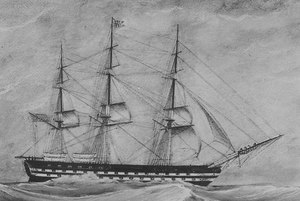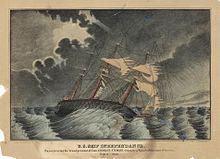USSIndependence(1814)

| |
| History | |
|---|---|
| Name | USSIndependence |
| Namesake | Declaration of Independence |
| Builder | Boston Navy Yard |
| Launched | 22 June 1814 |
| Decommissioned | 1822 |
| Refit | Razeed,1836 |
| Recommissioned | 26 March 1837 |
| Decommissioned | 3 November 1912 |
| Stricken | 3 September 1913 |
| Fate | Scrapped 1915 |
| General characteristics | |
| Type | Ship of the line |
| Tonnage | 2243 |
| Length | 190 ft 9 in (58.14 m) |
| Beam | 54 ft 7 in (16.64 m) |
| Draft | 21 ft 3 in (6.48 m) |
| Propulsion | Sail |
| Complement | 790 officers and enlisted |
| Armament | 90 × 32-pounder (15 kg) guns |
USSIndependencewas a wooden-hulled, three-masted ship, originally aship of the lineand the first to be commissioned by theUnited States Navy.Originally a 90-gun ship, in 1836 she was cut down by one deck and re-rated as a 54-gunfrigate.
Service history
[edit]Mediterranean Fleet, 1814–1822
[edit]
Launched on 22 June 1814 in theBoston Navy Yard,she immediately took on guns and was stationed withfrigateUSSConstitutionin Boston. She could not cruise until the end of theWar of 1812as she was blockaded in port by a squadron consisting of a number of 74-gun ships and the 98-gunHMSBoyne.Flying the broad pennant of CommodoreWilliam Bainbridge,and under command of CaptainWilliam M. Crane,she led her squadron fromBostonon 3 July 1815 to deal with piratical acts of theBarbary Statesagainst American merchant commerce.
Peace had been enforced by a squadron underStephen Decaturby the timeIndependencearrived in theMediterranean.But she led an impressive show of American naval might before Barbary ports that encouraged them to keep the peace treaties concluded. Having served adequate notice of rising U.S. seapower and added to the prestige of the Navy and the Nation,Independencereturned toNewport, Rhode Islandon 15 November 1815. She continued to wear the pennant of Commodore Bainbridge at Boston until 29 November 1819, then wasflagshipof CommodoreJohn Shawuntil placedin ordinaryin 1822.
Refit 1836
[edit]Independenceremained in ordinary at Boston until 1836 when she wasrazeed(cut down to one covered fighting deck withpoopandforecastle). She was rated down to 54 guns as her configuration gave way to that of a very large frigate. She proved to be one of the fastest and most powerful "frigates" of the Navy.
Russia, South America, Home Squadron, 1837–1845
[edit]
Independencerecommissioned on 26 March 1837 and sailed from Boston on 20 May 1837 as flagship of CommodoreJohn B. Nicholson.On board for her record passage across the Atlantic Ocean to England was the HonorableGeorge Dallas,Minister to Russia. She arrived atPortsmouth,England, 13 June, called atCopenhagen;then proceeded intoKronstadt29 July 1837 to receive a visit from the EmperorNicholas I of Russia.Two days later a steam boat arrived to transport Mr. Dallas and his family toSt. Petersburg.
Having received marked social courtesies from the Russian government,Independencedeparted Kronstadt on 13 August 1837 forRio de Janeiro,where she became flagship of theBrazil Squadronto guard American commerce along the eastern seaboard of South America. This duty continued into the spring of 1839 when Commodore Nicholson attempted mediation to end the war between France andArgentina.He reported 22 April 1839 that:
"I volunteered, as I conceived it a duty I owed to my Country, as well as to all Neutrals, to endeavor to get peace restored that commerce should be allowed to take its usual course. In accordance of the feelings of humanity at least, I hope my endeavors will be approved by the Department... I see no probable termination of this War and Blockade which is so injurious to the Commerce of all Neutrals..."
Independencereturned north toNew Yorkon 30 March 1840. She was laid up in ordinary until 14 May 1842 when she became flagship of CommodoreCharles Stewartin theHome Squadron.Based at Boston and New York, she continued as his flagship until laid up in ordinary on 3 December 1845.
Mexican War, 1846–1849
[edit]She recommissioned on 4 August 1846, and the nation was already atwar with Mexicoas she departed Boston 29 August 1846 for the coast of California. She enteredMonterey Bayon 22 January 1847 and became the flagship of CommodoreWilliam Shubrick,commanding thePacific Squadron.
Independenceassisted in the blockade of the Mexican coast, capturing Mexican shipCorreoand a launch on 16 May 1847. She was present to support the capture ofGuaymason 19 October and landedsailorsandMarinesto occupyMazatlánon 11 November 1847. She later cruised as far as Hawaii, arrivingHiloon 12 August 1848, arrivingLahainaon 30 August 1848 andHonolulu4 September 1848.[1]Independencereturned to the East Coast atNorfolk, Virginiaon 23 May 1849 and decommissioned there on 30 May.
Mediterranean, Pacific, 1849–1912
[edit]Recommissioned on 7 July 1849,Independencedeparted Norfolk on 26 July under CaptainThomas Conoverto serve as flagship of theMediterranean Squadronunder CommodoreCharles Morgan.She was the first U.S. man-of-war to show the flag atSpezia,Italy,arriving on 23 May 1850 to an enthusiastic welcome. She returned to Norfolk on 25 June 1852 and was placed in ordinary at New York on 3 July 1852.
Independencewas recommissioned in September 1854 and departed New York on 10 October to serve as flagship of the Pacific Squadron under CommodoreWilliam Mervine.She arrivedValparaíso,Chile, on 2 February 1855. Her cruising grounds ranged northward toSan Franciscoand west to Hawaii. Proceeding fromPanama Bay,she entered theMare Island Navy Yardon 2 October 1857. She served asreceiving shipthere until decommissioned on 3 November 1912. Her name was struck from theNavy Liston 3 September 1913.

Decommissioning and fate
[edit]Independencedid not leave the Mare Island Navy Yard until 28 November 1914. Sold toJohn H. Rinder,she was towed to theUnion Iron Works,San Francisco. On 5 March 1915 she shifted toHunters Point,and remained for a week. Some repairs were made and a plan formulated to use her as a restaurant for thePanama–Pacific International Exposition.But this plan was not executed though a permit was granted by Exposition authorities. Pig iron and ballast were removed from her hold and valuable hard wood salvaged from herorlop deckknees.On the night of 20 September 1915,Independencewas burned on the Hunter's Point mud flats to recover her metal fittings.
References
[edit]- ^Ships Log US Archives
- Howard Chapelle,The History of the American Sailing Navy: the Ships and their Development(New York: Norton, 1949), plan 27 (Independenceas a razee)
 This article incorporates text from thepublic domainDictionary of American Naval Fighting Ships.The entry can be foundhere.
This article incorporates text from thepublic domainDictionary of American Naval Fighting Ships.The entry can be foundhere.
